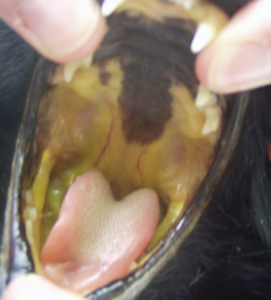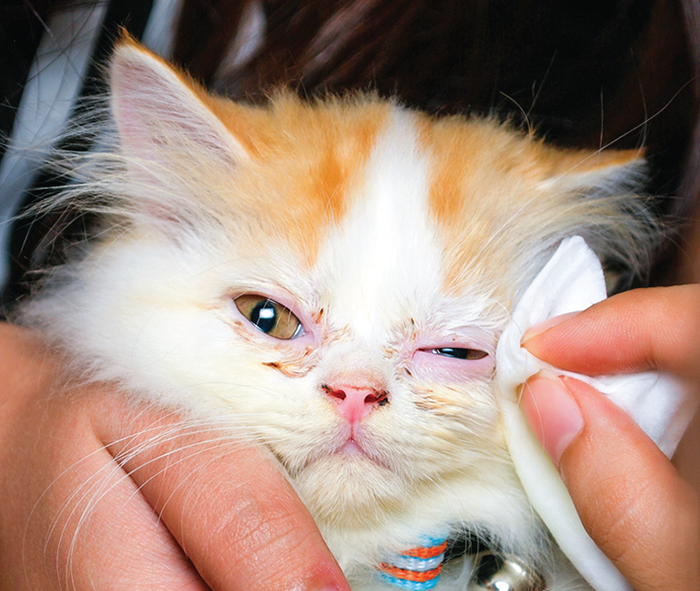One of the most common causes of upper respiratory infection (URI) in cats is feline calicivirus (FCV). Cats kept at home and/or in a small, stable group have about a 10% chance of being infected with this virus, while cats in more crowded conditions have a roughly 90% risk of infection.
The initial signs of calicivirus infection are similar to those seen in other URIs. You might notice a nasal or ocular discharge with sneezing or coughing. Affected cats often have conjunctivitis, which is a painful swelling of the mucous membranes around the eyes. It often causes a clear ocular discharge, and most cats squint or rub their eyes due to discomfort.
These cats usually feel and act unwell. They are commonly inactive and depressed and may develop oral ulcers, which can cause drooling and pawing at their mouths.
Some infected cats are left with chronic oral stomatitis, a painful inflammation/ulceration of the tongue, palate, lips, and inner cheeks, and gingivitis. Not surprisingly, an infected cat’s voice may sound different, and many cats develop a fever.
Affected cats’ appetites are often greatly diminished, as the oral ulcers can make eating painful; and the nasal discharge can block a cat’s sense of smell (a cat’s appetite is highly dependent on its ability to smell food).
Some cats, especially young kittens, may develop pneumonia due to secondary bacterial infections, often making them seriously ill. Older kittens and young cats may develop painful joint inflammation accompanied by respiratory signs. The lameness is often temporary without residual effects.

Eileen Fatcheric DVM photo
Spread
Calicivirus is a hardy virus, surviving for up to a month in the environment, depending upon conditions. It is usually spread through saliva and nasal secretions during direct contact between cats, but also via contaminated bowls, bedding, and even people. Bleach will kill the virus, but ordinary laundry detergent will not.
The incubation period for calicivirus is two to six days, followed by two to three weeks of illness in uncomplicated cases. An infected cat can shed the virus for a couple of weeks, even after they stop showing signs of illness. Some cats will continue to shed virus throughout their lifetime. “Carrier” cats rarely show any signs of illness but are infective. Female carriers can infect their kittens at birth.
Diagnostics
Diagnostic testing is not always necessary except in difficult or chronic cases, as a presumptive diagnosis is often made based upon characteristic clinical signs. A diagnosis can be confirmed by identifying genetic material of the virus in samples from the mouth, nose, or eyes (using PCR technology). Depending upon the severity of disease, X-rays of the lungs and/or acquisition of samples from the lungs via a procedure called a transtracheal wash may be pursued.
Treatment
Hospitalization is only necessary for severe cases. Home supportive care and isolation is generally adequate. You can use warm compresses to loosen crust on the eyes and nose. Your veterinarian may recommend saline nasal drops to loosen up debris. You can also use a nebulizer or keep your cat in the bathroom while you shower so that the steam can help ease her breathing.
To entice eating, try soft foods for easier swallowing. Warm savory items slightly in a microwave or add some tuna juice or low sodium chicken broth to increase the food’s smell.
Clean everything you can—bowls, toys, brushes, blankets, floors—used by the sick cat with a dilute bleach solution (1 part bleach to 32 parts water). Then, isolate her to a specific small area, which you will need to continually clean. It is also a good idea to wash your hands thoroughly after interacting with an infected cat.
Antibiotics are only used if a secondary bacterial infection develops. While some antiviral drugs have shown some promise in treating FCV infections, their usefulness is currently the subject of debate among veterinarians.
In cases with severe oral ulceration/inflammation, steroids may be prescribed by your veterinarian in an attempt to control the inflammation and make an infected cat more comfortable.
Prevention
Fortunately, both injectable and intranasal calicivirus vaccines are available, and FCV vaccination is considered a core vaccine that is recommended for all cats. While these vaccines may not prevent infection in all cases, they significantly decrease the incidence of serious illness and generally stop shedding of the virus.
The CaliciVax vaccine includes modified forms of a strain of FCV that causes FCV-associated virulent systemic disease (FCV-VSD) and a typical strain of FCV. This vaccine may offer some protection against outbreaks of FCV-VSD, according to the Baker Institute for Animal Health at Cornell, but since the virulent strains that cause these outbreaks arise from different mutations in less aggressive strains, the vaccine’s effectiveness is not yet clear. It is not a core vaccine.
Your cat should be appropriately vaccinated against calicivirus as prevention. Any cat showing signs of respiratory illness should be isolated from other cats in the family. If nursing care does not suffice to get her eating and feeling better within a couple of days—or if symptoms worsen—a veterinary visit is in order.
Mutant Strain of FCV
Rarely, a mutant strain of FCV will spontaneously arise, leading to FCV-associated virulent systemic disease or FCV-VSD. The first known outbreak of FCV-VSD occurred in Northern California in 1998. Unlike most viral upper respiratory infections in cats, this version has a high mortality rate of over 50%.
Cats with FCV-VSD usually become very sick. Along with a high fever, these cats may have swelling of the face, head, and limbs. Crusty sores may develop on the nose, around the eyes and ears and on the pads of their feet. Liver damage can lead to jaundice, a yellow pigmentation usually seen in the ears, mouth, and the whites of the eyes. Some cats will hemorrhage under the skin (looks like bruising) or in the intestinal tract, leading to blood in the stools.
The calcivirus mutates readily, which results in new strains of the virus that may not be fully covered by the currently available vaccination. However, a vaccinated cat usually has a less severe case of the virus.




